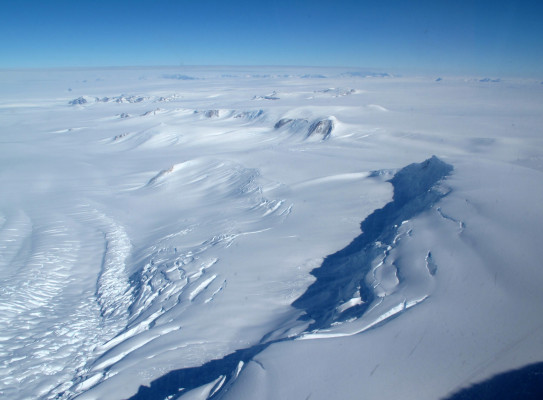
RICERoosevelt Island Climate Evolution Project

Ice cores from the Roosevelt Island Climate Evolution (RICE) Project in Antarctica provide us with vital clues about how the continent will behave in a warming world.
Overview
Of main concern is irreversible collapse of the West Antarctica Ice Sheet with the potential to dramatically change sea levels.
The scale of the Antarctic continent is difficult to comprehend. The continent is so large that the moon fits comfortably into the Antarctic circle. Its ice sheets (the East and West Antarctic ice sheets) hold the equivalent of about 60m global sea level. As the ice slowly flows from the centre of the continent to the ocean, the thick slabs of ice – called ice shelves – start to float, randomly creating large icebergs.
Of these, the Ross Ice Shelf is the largest in the world. It is the size of France. Beside it is the West Antarctic Ice Sheet – holding enough water to boost sea levels by 6-7 metres. The Ross Ice Shelf serves as a gatekeeper – slowing the flow from West and East Antarctica into the ocean. What happens if the Ross Ice Shelf loses its stability and starts to shrink? We need to find out now.
This project aims to
- improve our understanding of the stability of the Ross Ice Shelf and West Antarctic Ice Sheet in a warming world and the implications for global sea level change
To achieve these aims we are
- studying a 764m deep ice core to learn more about Antarctic/Southern Ocean climate conditions, with scientists from around the world
- developing a detailed view spanning the past 83,000 years
The core has the promise to also reveal conditions during the last interglacial – some 135,000 years ago – when the world was 1–2°C warmer than preindustrial times (before global temperatures increased due to human activity).
Data from this core will improve our understanding of ice sheet retreat and collapse. We can then assess and improve models used to project future change that seek to provide guidance on how quickly sea level will continue to rise, by how much and where we may cross thresholds for irreversible change.
Our partners are Australia, the People’s Republic of China, Denmark, Germany, Italy, Sweden, the UK and USA. New Zealand’s scientific team is drawn from GNS Science, Antarctic Research Centre at Victoria University of Wellington and Antarctica New Zealand. It is led by Associate Professor Nancy Bertler who holds dual roles at GNS Science and at Victoria University.
The project
Why Roosevelt Island?
Roosevelt Island isn’t really an island; rather it’s a small, ice-covered dome at the northern edge of the Ross Ice Shelf. Named for Franklin D. Roosevelt, it’s part of the Ross Dependency. The island is covered with ~760 meters (~2,500 ft) of ice at its summit. Scientists refer to it as a grounded “ice dome” with snow, and then ice, occurring slowly over millennia.
The location and nature of Roosevelt Island makes it ideal for studying what’s happening with the Ross Ice Shelf which acts as a major drainage pathway for the West Antarctic Ice Sheet. We don’t know how quickly the Ross Ice Shelf could retreat and what this means for 21st century sea-level rise. Collapse of multiple ice shelves and accelerated discharge of ice in the Antarctic Peninsula and Amundsen Sea where temperatures have already increased, suggest that such responses to global warming play a more significant role than we first thought. But what about the Ross Ice Shelf – one of two gateways for West Antarctic ice? When will we see its retreat? RICE aims to determine how quickly this might happen and the potential magnitude of sea-level rise.
Roosevelt Island Ice Core Drilling
Nancy Bertler describes an ice core drilling expedition to the Ross Ice Shelf, Antarctica for the Roosevelt Island Climate Evolution (RICE) project
Take one ice core
The ice core from Roosevelt Island is 764m long and acts like a climate archive, showing what has happened over the last 83,000 years and perhaps much longer. If we understand more about how the Ross Ice Shelf has behaved in the past, we may get new information on how West Antarctica may respond in a warming world.
Current conditions already locked in significant contributions from the Antarctic ice sheets to global sea level rise for centuries to come. As the world hurries to implement the Paris Agreement and reduce emissions, RICE aims to determine what the impact of these efforts are, how quickly sea level will rise and by how much, and whether a successful Paris Agreement could save the West Antarctic Ice Sheet from irreversible collapse that could play out over millennia, impacting future generations.
Time is precious – the recently released Intergovernmental Panel on Climate Change report notes that we have only about 10 years to halve emissions to still have a chance of achieving the Paris Agreement goals. Our teams are racing to quantify the consequences if we fail.

Research project details
Collaborators: Australia, the People’s Republic of China, Denmark, Germany, Italy, Sweden, the UK and USA. New Zealand’s scientific team is drawn from GNS Science, Antarctic Research Centre at Victoria University of Wellington and Antarctica New Zealand.
Duration
Funding platform
Status
Current
Leader
Nancy Bertler